AI-generated content is everywhere now. But so are AI detectors.
If you’re using ChatGPT, Claude, or any other AI tool for writing, you’ve probably wondered: “Can people tell this is AI-written?”
That’s where AI humanizer tools come in. They promise to make your AI text sound more human. But do they actually work?
I spent hours testing 14 different AI humanizer tools to find out. The results might surprise you.
What are AI Humanizer Tools?
An AI humanizer is a tool that rewrites AI-generated text. The goal is simple: make it sound like a human wrote it.
These tools work by changing sentence structure. They replace common AI phrases. They adjust the writing style and tone.
In 2025, AI detectors are getting smarter. Google is cracking down on AI content. Schools and employers are using detection tools more than ever.
If you’re creating content for:
- Blog posts and articles
- Academic assignments
- Marketing copy
- Social media posts
- Email campaigns
You need to know which AI humanizer tools actually work.
What I Tested and How I Ranked the Tools
I didn’t just test these tools randomly. I used a systematic approach.
First, I generated a random piece of content using ChatGPT. Then I ran the content through different AI humanizer tools. Finally, I tested the results with the GPTZero AI detector.
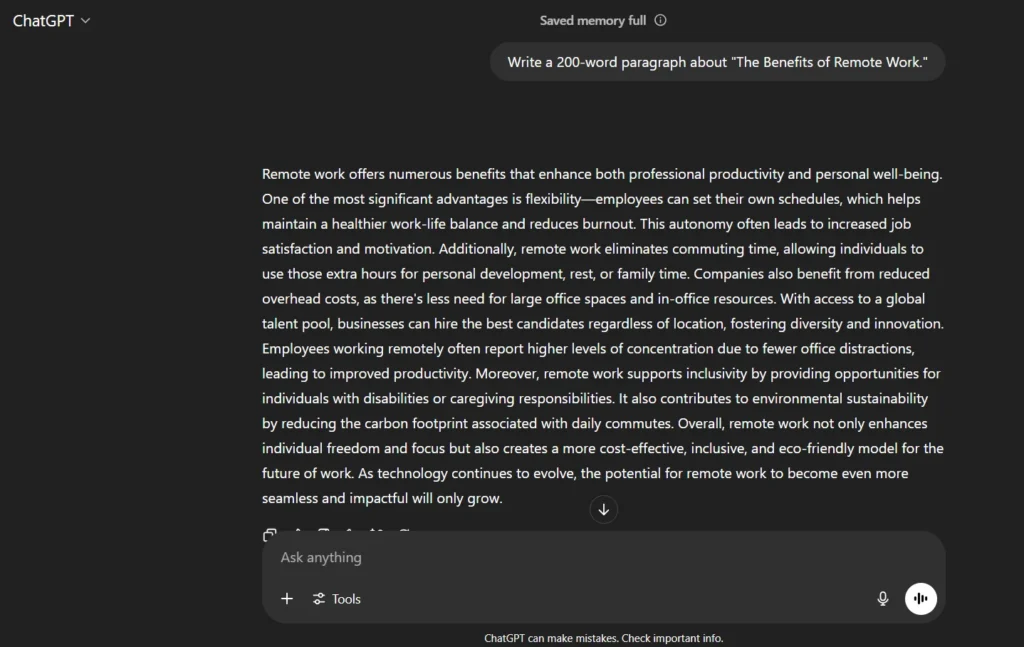
I ranked each tool based on three factors:
- Detection scores – How well did it fool AI detectors?
- Content quality – Did the text still make sense?
- Natural tone – Did it sound human or robotic?
TL;DR: Top 2 AI Humanizer Tools
Don’t have time to read the full review? Here are my top picks:
🥇 AI Humanize – Best overall performance, fooled AI detectors consistently
🥈 StealthGPT – Maintains the original intent of the content perfectly
Apart from AI humanier tools, I have also tested the 15 best AI image generators of 2025. Interested to know which one made it to the list? Click here to learn!
Testing Methodology
I used ChatGPT to create a paragraph about “The Benefits of Remote Work” of different word counts depending on the word limit of each AI bypasser I tested. This topic was chosen because:
- It’s common in business writing
- It has a clear structure
- It’s something AI often writes about
- It contains typical AI phrases and patterns
The original AI text scored 100% AI detection on GPTZero. This gave me a solid baseline to work with.

The Criteria for passing the test are as follows:
Those AI Humanizer tools that scored more than 85% as human-written content passed the test.
The tools that failed to score 85% or more as human-written content failed the test.
AI Detector Used
I tested each humanized version through GPTZero, a popular and free AI detector tool. This tool judges content through percentages. Higher percentages mean it is more likely to be AI-generated.
GPTZero was chosen because it’s widely used by educators and content creators. It provides clear percentage scores that are easy to interpret.
Top 2 AI Humanizer Tools That Passed
AI Humanize (8% AI)
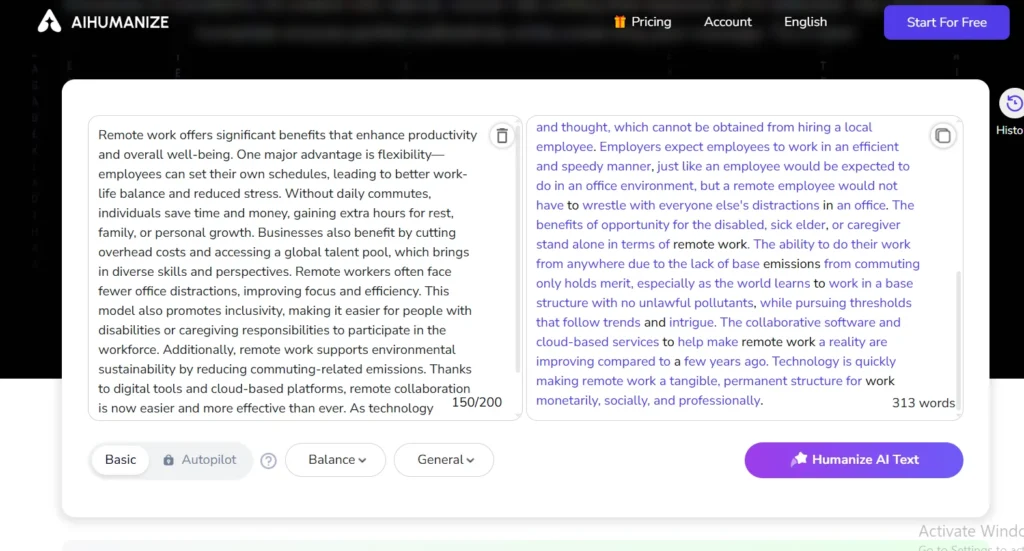
AI Humanize impressed me right from the start. This tool delivered the best results in my entire test.
The interface is clean and easy to use. You simply paste your AI text and click humanize. The tool works fast and processes content within seconds.
What makes AI Humanize special is its advanced rewriting algorithm. It doesn’t just change a few words here and there. Instead, it completely restructures sentences while keeping the original meaning.
The humanized text scored only 8% AI on GPTZero. This means 92% of the content appeared human-written. That’s an impressive result.
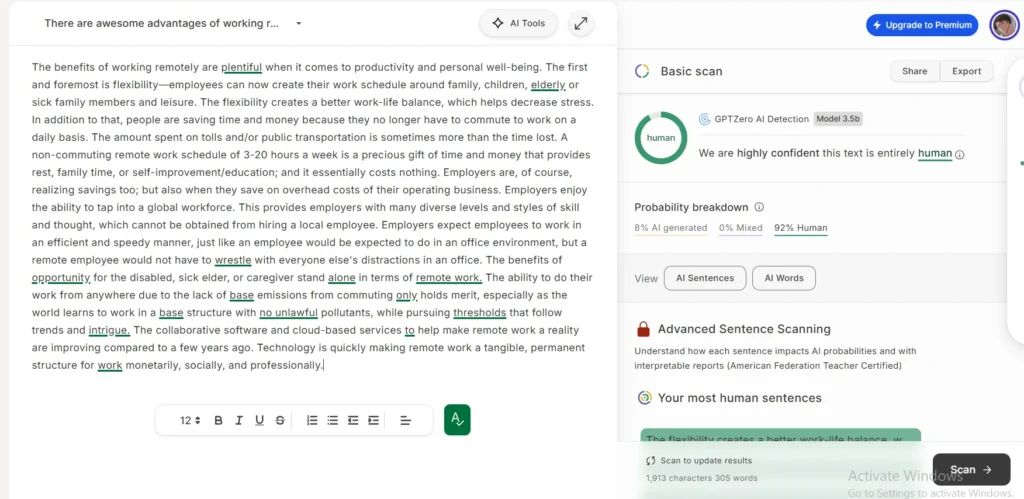
The quality of the rewritten content was excellent. All sentences made perfect sense. The flow was natural and easy to read.
AI Humanize offers both free and paid plans. The free version has a word limit. But it’s enough to test the tool’s capabilities.
Verdict:
Although AI Humanize expanded the content, it didn’t lose the original intent. The tool converted a 150-word paragraph into a more than 300-word paragraph after humanizing.
Some of the sentences were really long and complex. Moreover, some fancy lexical items were also used once or twice.
Overall, it maintained the context of the topic while expanding the details further. AI Humanize is an ideal tool if you want your text humanized at the cost of a few extra details added to your content.
Pros:
- Excellent AI detection bypass rate
- Maintains content quality
- Fast processing speed
- User-friendly interface
Cons:
- Limited free word count
- Premium features require a subscription
StealthGPT (11% AI)

StealthGPT came in second place with an 11% AI detection score. This tool focuses on maintaining the original message while making text sound human.
The setup process is straightforward. You create an account and paste your content. The tool offers different humanization modes for various content types.
What I liked about StealthGPT is its attention to context. It doesn’t just randomly change words. The tool understands the meaning and rewrites accordingly.
The humanized content felt natural to read. Technical terms were preserved correctly. The overall message remained clear and coherent.
StealthGPT works well for academic papers and professional content. It’s particularly good at handling complex topics without losing meaning.
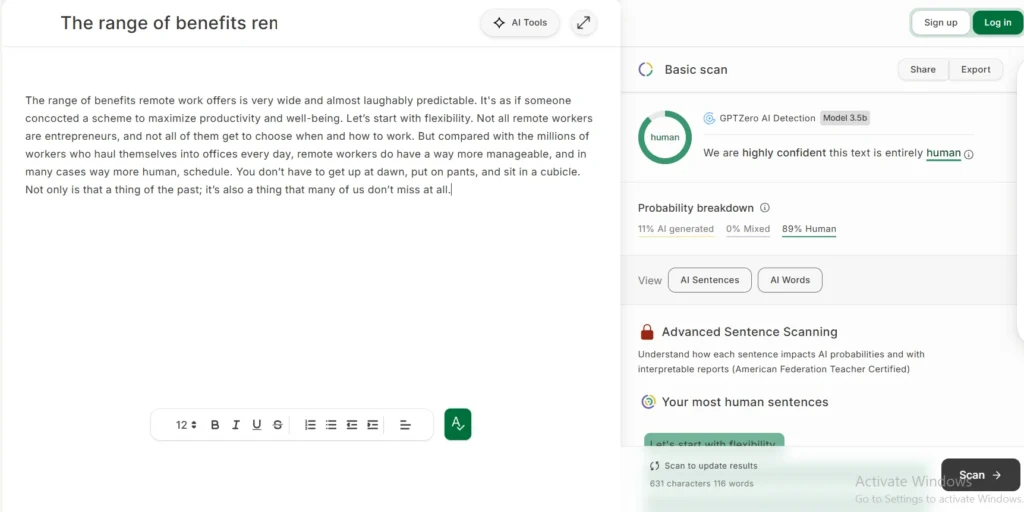
The tool offers a free trial. After that, you need a subscription to continue using it. The pricing is reasonable for the quality it delivers.
Verdict:
Unlike AI Humanize, StealthGPT shortens the content while keeping the context intact. The standout feature of this tool is its ability to convert the robotic-sounding tone into an extremely human-like, friendly, and casual tone.
It produced short sentences and human-like sentence structures. The use of everyday vocabulary was apparent in the humanized output. In addition, StealthGPT also used analogy in the content, a human-like characteristic.
All in all, this AI humanizer tool is perfect if you want your content to sound human.
Pros:
- Strong AI detection bypass
- Preserves original meaning
- Good for academic content
- Multiple humanization modes
Cons:
- Requires subscription after trial
- Slightly slower than other tools
Detailed Comparison Table
| Feature | AI Humanize | StealthGPT |
| AI Detection Score | 8% AI (92% Human) | 11% AI (89% Human) |
| Test Result | ✅ PASSED | ✅ PASSED |
| Content Quality | Excellent | Excellent |
| Processing Speed | Fast (seconds) | Medium (30-60 seconds) |
| Free Plan | Limited words | Free trial only |
| Pricing Plans | Basic Plan: $5/Month | Essential Plan: $24.99/month |
| Word Limits | Free: 200 words/detection 15,000 words on Basic Plan | Essential Plan: Unlimited Words |
| Best For | General content, blogs | Academic papers, professional content |
| Humanization Modes | Standard mode | Multiple modes available |
| Interface | Clean and simple | Professional dashboard |
| Special Features | Advanced rewriting algorithm | Context-aware processing |
| Money-Back Guarantee | Not specified | Not specified |
| Customer Support | Email support | Email support |
| Overall Value | Best overall | Best for academic use |
Instead of relying on AI Humanizers, you can master prompt engineering to get human-like outputs. Here is a list of top ChatGPT productivity tips to help get you started!
AI Humanizer Tools that Failed the Test
WriteHuman (100% AI)
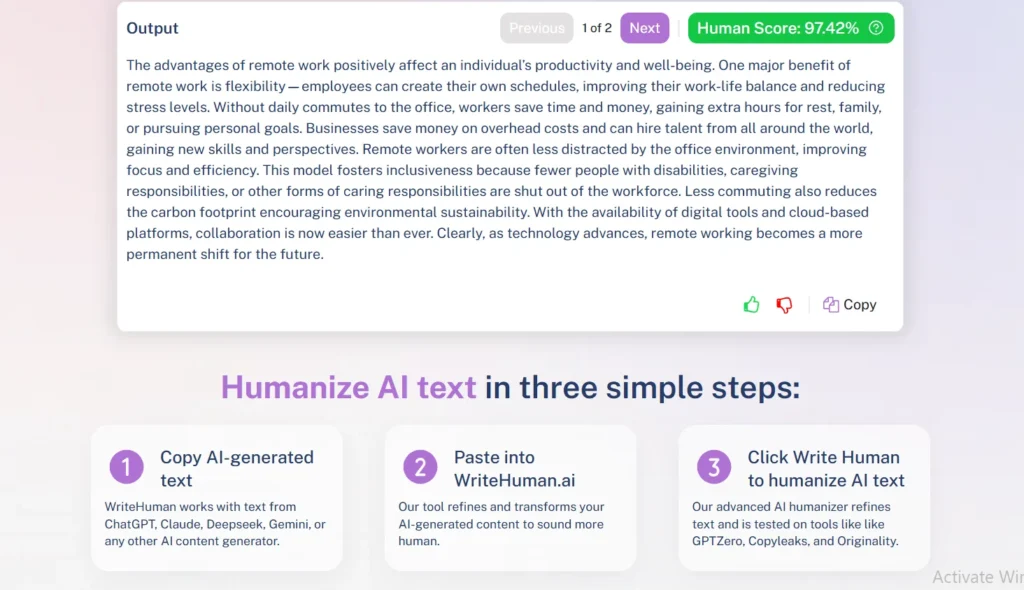
WriteHuman was a complete disappointment. Despite its promising name, it failed to humanize the content at all.
The tool kept the original AI text almost unchanged. It only made minor word substitutions. The sentence structure remained exactly the same.
GPTZero detected the humanized content as 100% AI-generated. This means WriteHuman made zero improvement to the original text.
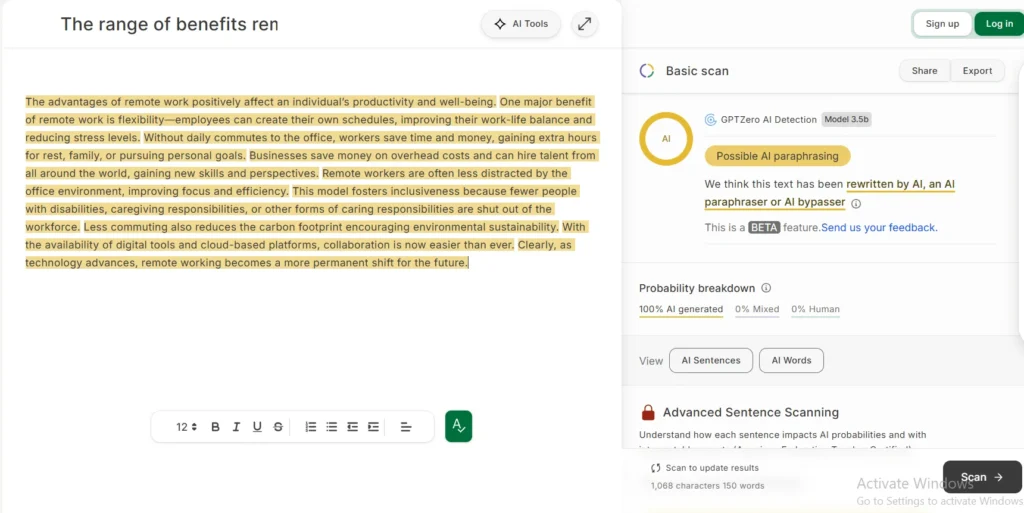
The interface looks modern and professional. But the actual performance doesn’t match the design quality.
WriteHuman offers a free tier with limited usage. However, even the paid version failed to deliver results in my testing.
Why it failed: No significant changes to sentence structure or writing patterns. All it did was use different synonyms and change up the sentence structure a bit.
Additionally, it didn’t bother to exclude dashes from the AI-generated content, something that is a hallmark of AI-written content.
WriteHuman also generated long and complex sentences in the output, which is not a good sign in the eyes of AI detectors.
QuillBot (100% AI)

QuillBot is primarily known as a paraphrasing tool. Many people use it, hoping to humanize AI content. Unfortunately, it doesn’t work for this purpose.
The tool did rephrase some sentences. But the changes weren’t enough to fool AI detectors. The writing style remained distinctly AI-like.
QuillBot kept common AI phrases and patterns. It didn’t address the core issues that make text detectable as AI-generated.
The rewritten content scored 100% AI on GPTZero. This shows that basic paraphrasing isn’t enough to bypass modern AI detectors.
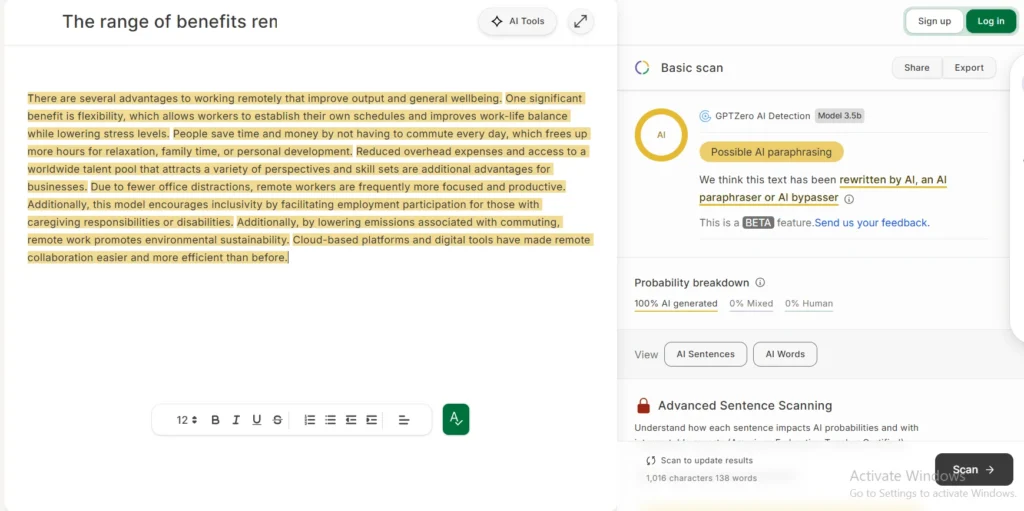
QuillBot is still useful for general paraphrasing tasks. But it’s not an effective AI humanizer tool.
Why it failed: Basic paraphrasing doesn’t change AI writing patterns.
Monica AI Humanizer (100% AI)
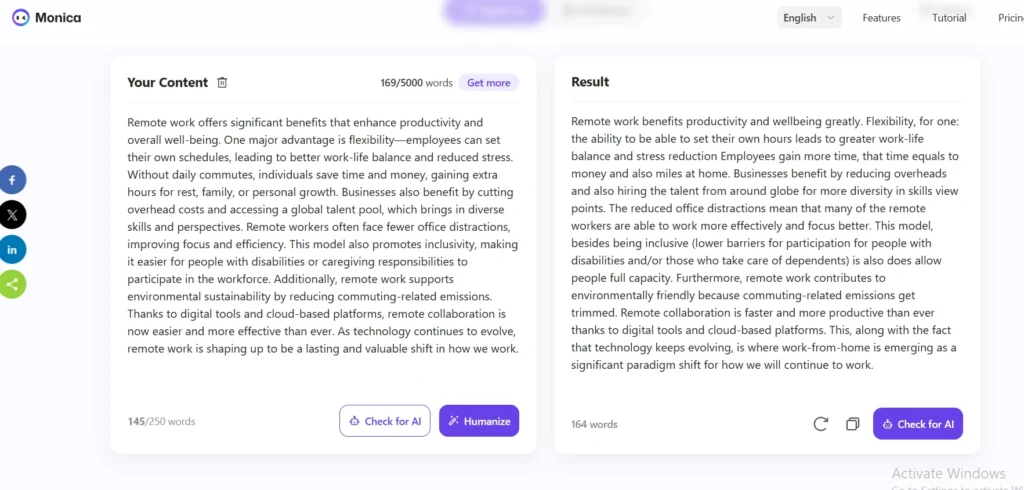
Monica AI Humanizer promised to make AI text undetectable. The reality was quite different from the marketing claims.
The tool made minimal changes to the original content. Most sentences remained identical. Only a few words were replaced with synonyms.
These surface-level changes weren’t enough to fool GPTZero. The humanized text still scored 100% AI detection.
Monica’s interface is clean and easy to navigate. The processing speed is fast. But speed doesn’t matter if the results are poor.
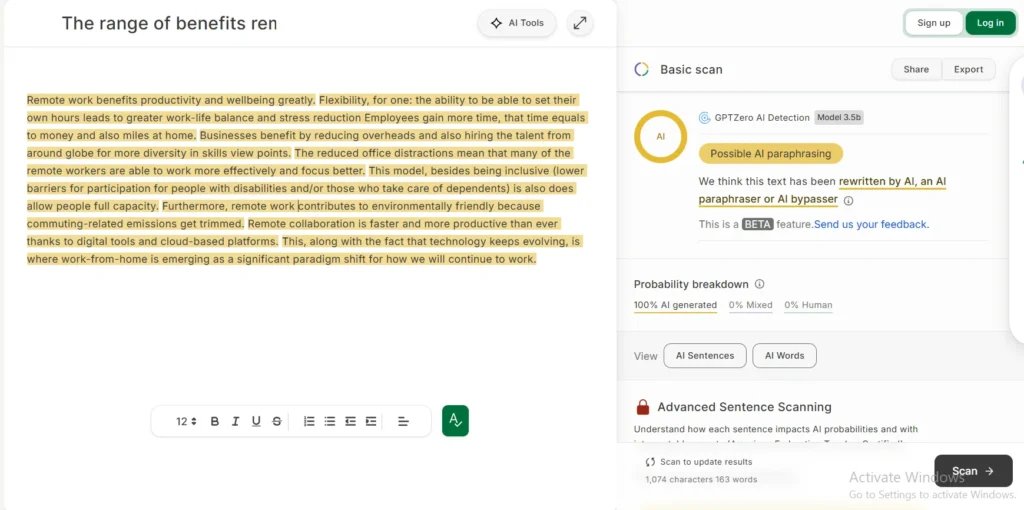
The tool offers both free and premium versions. However, even the premium features couldn’t improve the humanization quality.
Why it failed: Only made cosmetic changes without addressing AI writing patterns. Monica Ai Humanizer used complex sentences just like generic ChatGPT-generated content.
Moreover, there was no coherence or flow in the content structure. Hence, making the content sound really robotic and flavourless.
Writesonic AI Humanizer (91% AI)

Writesonic AI Humanizer scored 91% in the AI detection test, meaning only 9% appeared human-written. It was honestly disappointing cause I expected more from this tool.
The tool did make more significant changes than previous failures. It restructured some sentences and replaced AI-common phrases.
However, the changes weren’t consistent throughout the text. Some paragraphs remained heavily AI-like while others improved slightly.

Writesonic’s interface is polished and professional. The tool processes content quickly and provides clear results.
The humanized content was readable and maintained good quality. But it still triggered AI detectors too frequently.
Why it failed: Inconsistent humanization across the entire text. While some sentences were human-like, the others lacked organic touch and coherence. Plus, dashes were also present, which is a big no-no in the domain of human-written content.
HIX AI (88% AI)
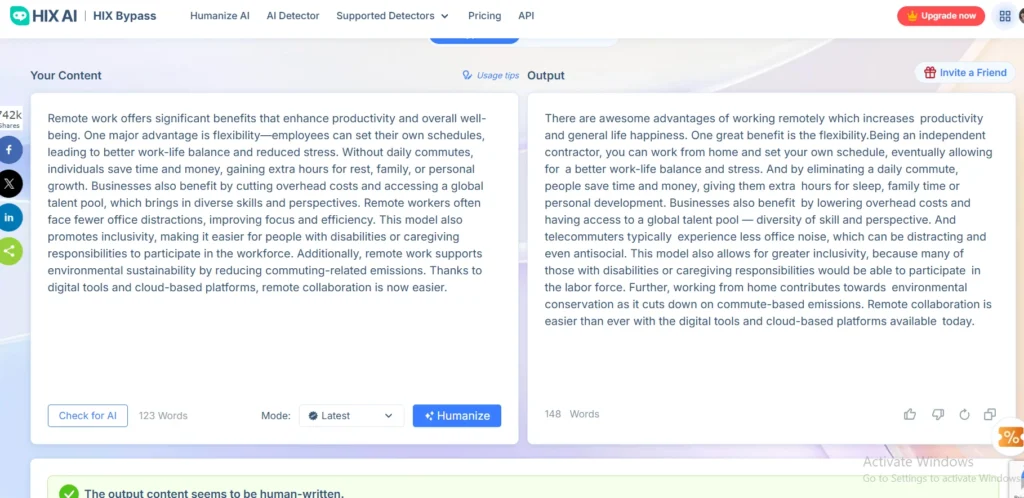
HIX.AI scored 88% AI detection, not enough to be considered a reliable AI-to-human generator tool. This tool showed promise but couldn’t quite deliver the results needed.
The humanizer made decent attempts at restructuring sentences. It replaced some obvious AI phrases with more natural alternatives.
However, the overall writing style still felt robotic. The tool kept certain patterns that AI detectors easily recognize.
HIX.AI offers multiple writing tools beyond just humanization. The platform is comprehensive but lacks focus on AI detection bypass.
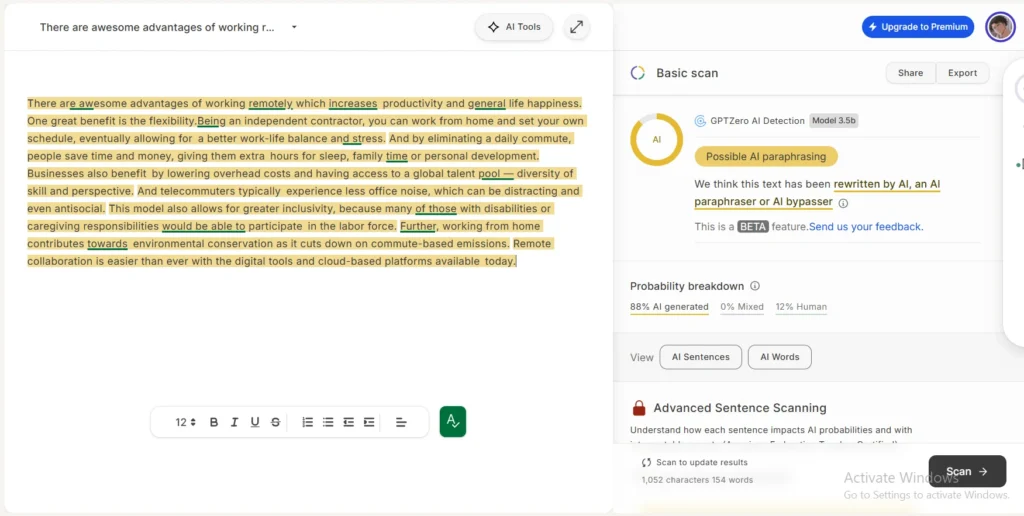
The processing speed is good, and the interface is user-friendly. Content quality remained high after humanization.
Why it failed: Couldn’t fully eliminate AI writing patterns despite decent attempts. In addition, the tool used overly academic writing patterns and complex lexical items. That contributed to changing the vibe of the content.
Netus AI (100% AI)

Netus AI completely failed to humanize the test content. The output scored 100% AI detection on GPTZero.
The tool made very few changes to the original text. Most sentences remained exactly the same. Only occasional word substitutions occurred.
These minimal changes had no impact on AI detectability. The writing style and structure stayed completely AI-like.
Netus AI’s interface is basic but functional. The tool processes content quickly. However, speed is meaningless without effective humanization.
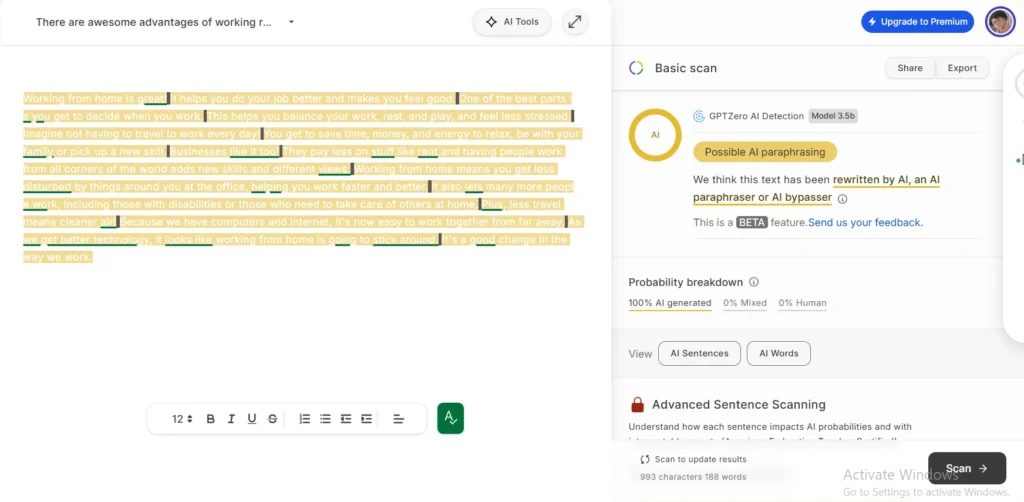
The tool offers free and paid tiers. But neither version delivered satisfactory results in my testing.
Why it failed: In an attempt to make it human, Netus AI goes overboard. The output generated by this tool is overly simplified, as if written for a 5-year-old kid, which changes the target audience of the content.
Also, the sentences are extremely short, and at times, the structure doesn’t make sense.
BypassGPT (81% AI)

BypassGPT scored 81% in the AI detection test, falling well short of the 85% passing threshold. This was one of the closer failures in my testing, considering the rest.
The tool made noticeable improvements to the original content. It changed sentence structures and replaced AI-common phrases.
However, the humanization wasn’t thorough enough. Some sections remained heavily AI-like while others improved significantly.
BypassGPT’s interface is straightforward and easy to use. The tool processes content at a reasonable speed.
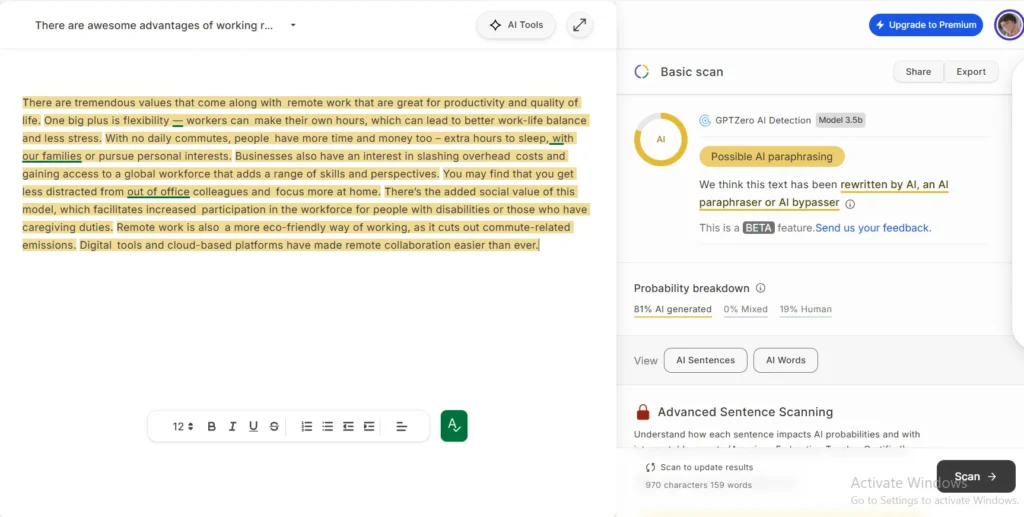
The quality of humanized content was good. However, there were massive errors in cases where the synonyms used for some words didn’t fit in the context of the topic.
Why it failed: Uneven humanization quality across different sections of text. Incorrect synonyms were used at times, for example, “Remote Workers” was replaced with “Out of Office Colleagues,” which sounds quite unusual and out of place.
Smodin AI Humanizer (100% AI)
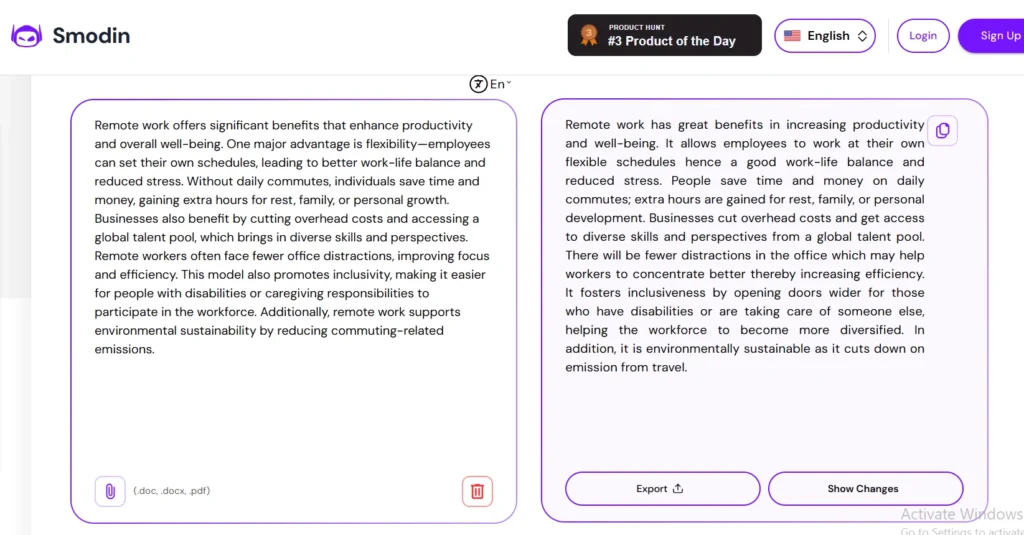
Smodin AI Humanizer didn’t perform well in my testing. The tool failed to achieve the 85% human threshold required to pass.
The humanization attempts were inconsistent. Some sentences improved while others remained unchanged.
Smodin made basic word substitutions but didn’t address deeper AI writing patterns. The overall structure stayed AI-like.
The tool’s interface is clean and modern. Processing speed is acceptable for most content lengths.
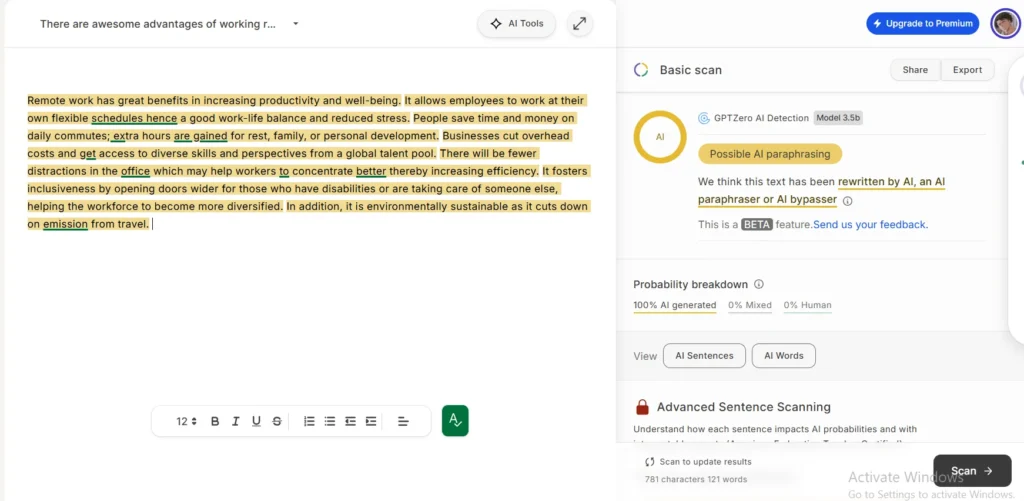
However, the core functionality of bypassing AI detection wasn’t effective enough.
Why it failed: Surface-level changes without addressing core AI patterns. Also, lengthy sentences were used at times.
Humanize AI (100% AI)
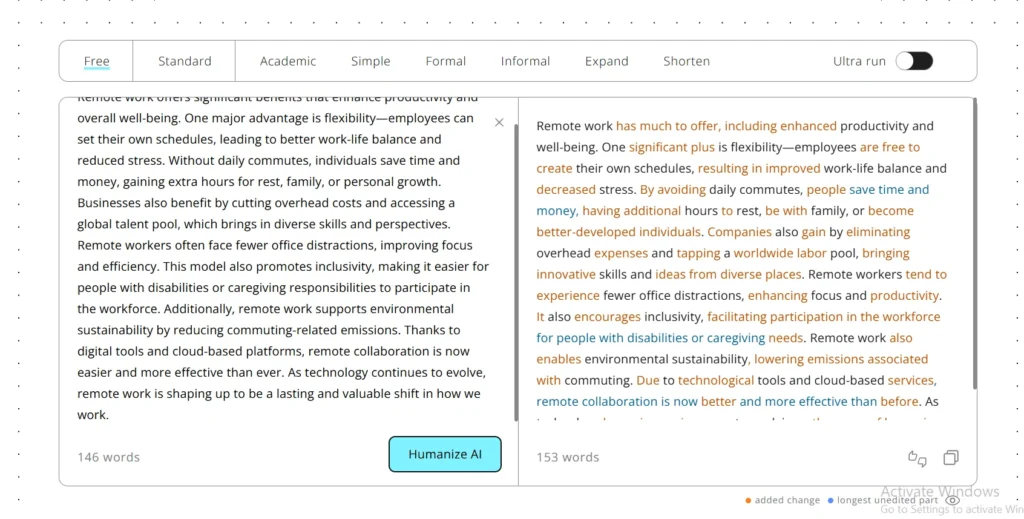
Despite its name suggesting expertise in humanization, this tool completely failed the test. The content scored 100% AI detection after processing.
Humanize AI made minimal changes to the original text. The sentence structure remained identical. Only a few words were swapped with synonyms.
These cosmetic changes had zero impact on AI detectability. The writing style stayed completely robotic.
The tool’s interface looks professional and modern. But the actual performance doesn’t match the visual appeal.
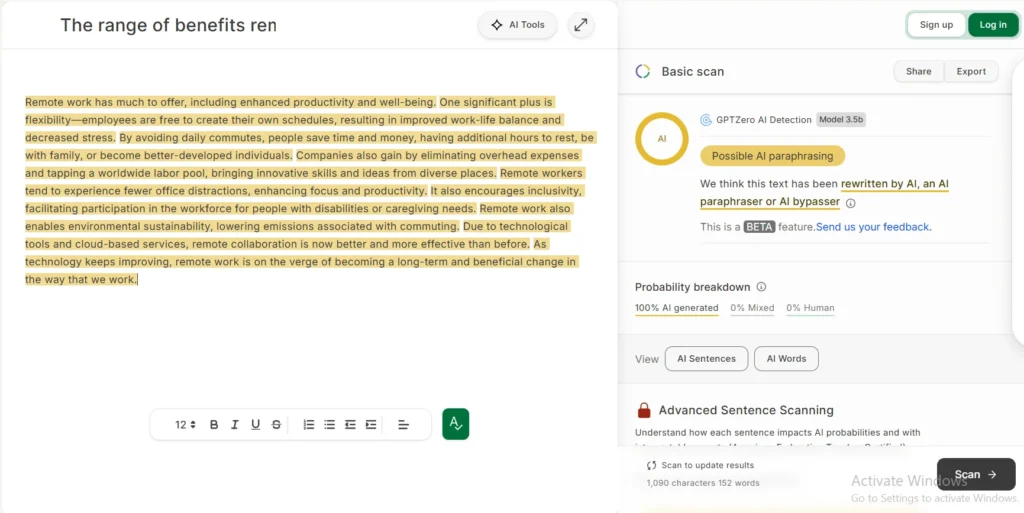
Why it failed: Only made superficial word changes without structural improvements.
GPTinf (100% AI)
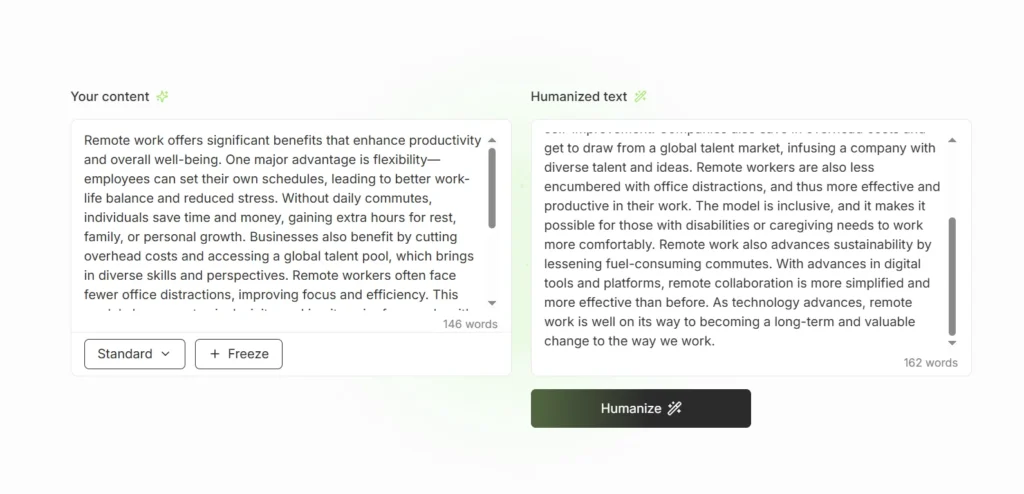
GPTinf promised to make AI content undetectable, but delivered the opposite results. The humanized text scored 100% AI detection.
The tool barely modified the original content. Most sentences stayed exactly the same. The few changes made were insignificant.
GPTinf kept all the AI writing patterns that detectors easily identify. No structural changes were made to improve human-likeness.
The interface is simple and straightforward. Content processing happens quickly. But effectiveness is more important than speed.

The tool offers subscription plans, but the results don’t justify the cost.
Why it failed: Failed to make any meaningful changes to AI-generated content.
Phrasly (100% AI)

Phrasly completely failed to humanize the test content. The output scored 100% AI detection, showing no improvement from the original.
The tool made only minor word substitutions. Sentence structure remained identical to the AI-generated input.
These minimal changes weren’t enough to fool modern AI detectors. The writing style stayed robotic and artificial.
Phrasly’s interface is clean and user-friendly. The tool processes content at a decent speed.

However, the core functionality of the AI detection bypass was completely ineffective.
Why it failed: Only made cosmetic word changes without addressing AI writing patterns. The output lacked any character, flavour, or style, hence, the content looked quite dull.
StealthWriter (100% AI)

StealthWriter’s name suggests stealth capabilities, but the results showed otherwise. The humanized content scored 100% AI detection.
The tool made very few changes to the original text. Most sentences remained exactly as they were in the AI-generated version.
The few modifications made were superficial word replacements. No structural or stylistic improvements occurred.
StealthWriter’s interface is modern and appealing. Processing speed is fast and reliable.

But the actual humanization performance was completely inadequate for bypassing AI detection.
Why it failed: StealthWriter just added some synonyms and changed the sentence structure a bit without implementing any significant improvements. Further, the content contained some complex sentences, making it sound more AI.
Final Thoughts
After testing 14 different AI humanizer tools, the results were eye-opening. Only 2 tools managed to pass the 85% human threshold.
Most AI humanizer tools are simply not effective. They make surface-level changes that don’t fool modern AI detectors. Many tools scored 100% AI detection, showing they made no real improvement.
The two tools that passed – AI Humanize and StealthGPT – succeeded because they understand what makes text detectable. They don’t just change words. They restructure sentences and adjust writing patterns.
Here’s what I learned from this extensive testing:
Free tools rarely work. Most free AI humanizer tools are ineffective. They’re designed to get you to upgrade to paid plans.
Word substitution isn’t enough. Simply replacing words with synonyms doesn’t fool AI detectors. You need structural changes.
Quality matters more than speed. The best tools take time to properly analyze and rewrite content. Instant results are usually poor results.
Context preservation is crucial. Good AI humanizer tools maintain the original meaning while changing the writing style.
AI detectors are getting smarter. Basic humanization techniques that worked in 2023 don’t work in 2025.
If you need to humanize AI content, stick with proven tools like AI Humanize or StealthGPT. Don’t waste time with tools that promise everything but deliver nothing.
Remember that even the best AI humanizer tools aren’t perfect. Always review the output for quality and accuracy. The goal is to create content that’s both undetectable and valuable to readers.
The AI detection arms race will continue. Tools will improve on both sides. But for now, you know which AI humanizer tools actually work and which ones are just marketing hype.
——————————————————————————————————————————-
FAQs About AI Humanizers
Are AI humanizers safe to use?
Yes, reputable AI humanizers are generally safe for content processing. Most established platforms have privacy policies protecting user data. They don’t store content permanently or share it with third parties.
However, exercise caution with sensitive information. Don’t paste confidential business data into any online tool. Personal information should also be handled carefully.
Can Google detect AI even after humanization?
Google’s exact AI detection capabilities aren’t publicly confirmed. The company states it focus on content quality over creation method. However, their algorithms are increasingly sophisticated.
Google likely can detect some AI patterns even after humanization. The key is creating genuinely valuable content regardless of origin. Use humanizers to improve readability, not deceive search engines.
Is using AI humanizers ethical?
Ethics depend heavily on context and disclosure requirements. The situation determines what’s appropriate and what crosses ethical lines.
Generally acceptable uses:
- Improving AI-generated drafts for personal projects
- Enhancing tone and readability for better communication
- Creating marketing copy with proper human oversight
- Writing assistance for non-native speakers
Potentially problematic uses:
- Academic assignments without required disclosure
- Professional writing claimed as completely human-created
- News articles without transparency about AI assistance
- Any context specifically requiring original human thought
When in doubt, err on the side of transparency and disclosure.


1 thought on “I Tested 14 AI Humanizer Tools: Only 2 Passed the Test (With Proof)”